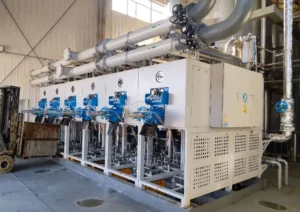As global environmental regulations tighten and industries move toward Zero Liquid Discharge (ZLD) systems, efficient wastewater treatment technologies are becoming increasingly vital. Sectors such as hazardous waste disposal, chemical manufacturing, mining, and landfill leachate management face mounting pressure to reduce water usage, manage complex effluents, and comply with discharge limits.
Evaporation is one of the most reliable and widely adopted technologies for concentrating and reducing the volume of industrial wastewater. Among the many options, Low-Temperature Vacuum Evaporators (LTE), Mechanical Vapor Recompression (MVR) systems, and Multiple-Effect Evaporators (MEE) are three dominant technologies. This article provides a detailed comparison between these systems, evaluating their performance, operating costs, and suitability for different types of industrial wastewater.
Comparison Summary Table
| Item | LTE (Skid) | MVR | MEE (Two/Three Effects) |
| Operating Cost (OPEX) | 50–60 RMB/ton | 90–100 RMB/ton | 110–140 RMB/ton |
| Installation | Skid-mounted, plug-and-play | Large footprint, on-site work | Large footprint, extensive installation |
| Automation | Fully automatic, no operator | Manual operation required | Manual operation required |
| Maintenance | Easy cleaning, low risk | Prone to clogging/fouling | High scaling, high cleaning cost |
| Energy Efficiency | Low energy, no steam needed | Good reuse of latent heat | High steam consumption |
| Concentration Ratio | High (8–10x typical) | Moderate | Moderate |
| Suitability | Sticky, scaling-prone, complex wastewater | Stable, low-scaling water | Large-volume, low-complexity waste |
Key Advantages of Low-Temperature Vacuum Evaporators (LTE)
1. Lower Operating Costs
One of the most significant benefits of LTE systems is their low operational expenditure. With OPEX typically ranging between 50–60 RMB/ton, LTE units are far more cost-effective than MVR or MEE systems. This is primarily due to their energy-efficient design, which operates without steam or high-pressure mechanical components. Lower energy input directly translates to reduced utility bills and operational expenses over time.
2. No Dependence on Steam or Circulating Water
Unlike MEE systems that require large boilers, steam pipelines, and cooling towers, and MVR systems that demand compressors and circulating water, LTE operates solely on electricity. This makes LTE:
-
Easier to deploy in remote or water-scarce regions
-
More scalable and modular
-
Safer, due to the absence of high-pressure components
This independence from complex utilities makes LTE a robust choice for installations where simplicity and reliability are top priorities.
3. Skid-Mounted, Plug-and-Play Installation
LTE units are delivered fully assembled and factory-tested, minimizing the time and resources required for on-site setup. The compact, skid-mounted design eliminates the need for extensive civil work, pipefitting, or auxiliary infrastructure. This not only reduces installation costs but also accelerates commissioning, allowing for faster time-to-operation.
4. Fully Automated Operation
LTE systems come with intelligent automation, including:
-
One-click startup
-
Remote monitoring
-
Auto-cleaning cycles
-
Alarm and fault diagnostics
As a result, no full-time operator is needed, which significantly lowers labor costs and minimizes human error. This feature is especially advantageous for unmanned facilities or operations running 24/7.
5. Superior Performance for Scaling-Prone and Sticky Wastewater
Operating at temperatures between 35–45°C, LTE minimizes the risk of salt crystallization and scaling, which are common in high-temperature systems. Its anti-fouling heat exchanger design and self-cleaning features enhance long-term performance and reduce downtime. LTE is particularly well-suited for:
-
Landfill leachate and mother liquor
-
High-salinity industrial wastewater
-
Pharmaceutical, textile, and chemical effluents with complex organics
6. High-Quality, Reusable Distillate
The distillate from LTE systems is clean, stable, and often meets standards for reuse or discharge without the need for post-treatment. This makes LTE valuable for industries pursuing closed-loop water reuse or minimal liquid discharge strategies.

Challenges and Limitations of MVR and MEE
While MVR and MEE are widely used in large-scale wastewater treatment, they come with a number of drawbacks:
Mechanical Vapor Recompression (MVR)
-
Complex operation involving compressors, pressure balancing, and vapor flow control
-
Sensitive to variations in feedwater quality, which can lead to performance instability
-
Requires skilled technicians for maintenance and tuning
-
Moderate energy efficiency, but higher CAPEX and maintenance costs
Multiple-Effect Evaporator (MEE)
-
High steam consumption results in elevated energy costs
-
Systems are bulky, requiring dedicated boiler rooms, condensate recovery systems, and cooling infrastructure
-
Frequent scaling and fouling of heat exchangers lead to increased cleaning frequency
-
Better suited for homogeneous, low-scaling wastewaters in industries with steam readily available
Choosing the Right Technology: When to Choose LTE?
LTE is Ideal When:
-
You need a cost-effective solution with minimal operational oversight
-
Your wastewater is viscous, scaling-prone, or high in salt content
-
The project is located in a remote or water-stressed area
-
Footprint and installation time are limited
-
You seek maximum automation and minimal maintenance
Conclusion
Selecting the optimal evaporation system depends on the nature of the wastewater, project scale, energy availability, and economic factors. While MVR and MEE systems still hold value for consistent, large-volume industrial streams with stable compositions, they come with high energy demands and significant maintenance requirements.
In contrast, Low-Temperature Vacuum Evaporators (LTE) offer a next-generation solution—combining energy efficiency, high automation, compact design, and flexibility. With the rising need for sustainable, cost-efficient ZLD systems, LTE technology is emerging as the preferred choice for industries tackling complex wastewater treatment challenges.
